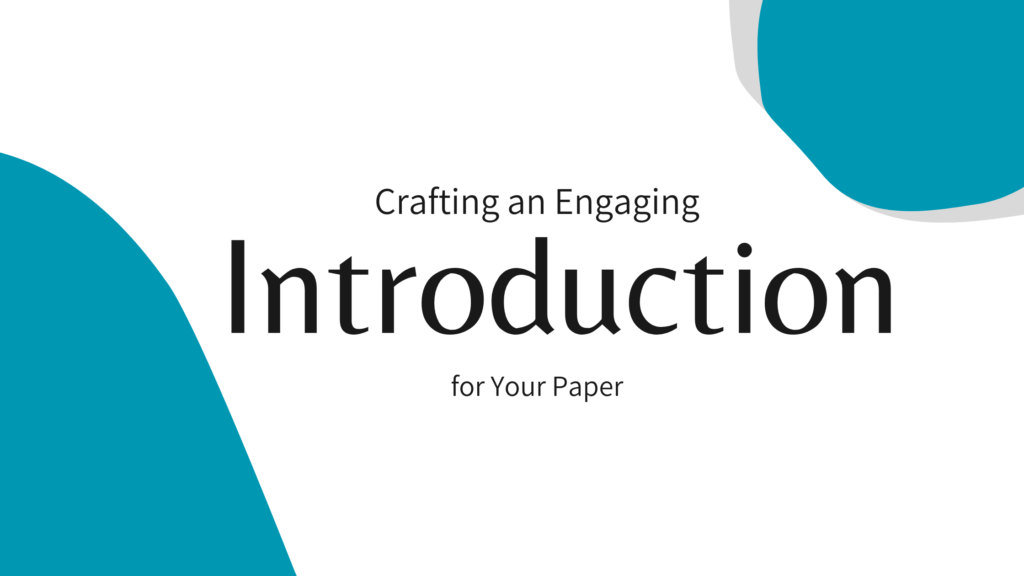
Crafting an engaging introduction is highly important as it engages readers and captures their attention and sets the tone for the rest of the paper. In this blog post, we will share some guidelines on writing the introduction section of a scientific paper.
Crafting an Engaging Introduction
Start with a general statement
Begin the introduction section with a general statement that gives the reader an overview of the research topic. This statement should be broad enough to attract the reader’s attention and set the stage for the study’s more specific details.
Provide background information
Once you have captured the reader’s interest, provide necessary background information about the research topic. This information can include historical or theoretical context that frames the research problem or questions being addressed.
State the research problem or questions
Next, clearly state the research problem or research questions that the study aims to address. This statement should connect the previous background information to the specifics of the study, helping to explain why the research is important and necessary.
Mention the study’s design and methodologies
In brief, explain the research design and methods utilized to conduct the study. This may include a sentence or two about the sample size and recruitment procedures, the data collection and analysis methods, and any necessary ethical approvals.
Discuss the key findings and significance
Finally, provide a sentence or two about the study’s key findings and its significance. It is necessary to link the study’s key findings back to the research questions addressed in the introduction and explain how these findings contribute to the field.
Conclude the introduction section
At the end of the introduction section, provide the thesis statement – a concise statement that summarizes the purpose and main arguments of the entire paper.
In scientific research papers, there are phrases that are commonly used to introduce the work, and we will look at some of them.
General introduction
The general introduction is a standard phrase used in many scientific research papers. The phrase typically comes in the beginning paragraph of the introduction section and aims to give an overview of the research topic. It is an excellent way to create context and provide background information to readers.
Research tradition
The phrase “Research on __ has a long tradition” is commonly used in scientific research papers to introduce the research topic. This phrase is often followed by a brief history of the research topic and highlights the significance of the research.
State-of-the-Art
The introduction section is an opportunity to highlight the current state of research in the field. Therefore, scientific researchers use the phrase “State-of-the-art” to show the current status of research in the field.
Research gap
Highlighting the gap in the current research is an essential aspect of any scientific research paper. Scientists often use phrases like “Despite extensive research in this area” or “previous research has failed to address the issue of” to signify gaps in the existing research.
Research objectives and questions
Scientific writers use phrases like “The objective of this research is to” or “The research question addressed in this paper is” to introduce their research objectives and questions.
Significance and advantages
In scientific research, it is crucial to underline the significance of the research. Therefore, phrases such as “The work presented in this paper is significant because” or “The main advantage of this study is” are commonly used in the introduction section of a research paper.
The above phrases are commonly used by researchers to introduce their work in the introduction section of their research papers. By using these phrases, researchers aim to set the tone for the rest of the paper and provide a clear framework for their research.
In conclusion, an effective introduction should have a clear research question or problem, a concise statement of the research design and methods, and a summary of the study’s key findings and significance. The opening paragraph should capture the readers’ attention and interest, and the final sentence should provide a clear thesis statement for the paper. By following these guidelines, you can provide readers with a clear and compelling reason to continue reading your research paper.
If you need any assistance with English editing or improving your manuscript, please don’t hesitate to get in touch with us. Our team of skilled editors is ready to help you improve the clarity, coherence, and overall quality of your writing. Contact us today to learn more about our services and how we can help you achieve your goals in academic publishing.
Further Readings
[1] Librarians R. Research Guides: Organizing Academic Research Papers: 4. The Introduction. https://library.sacredheart.edu/c.php?g=29803&p=185916 (accessed March 19, 2023).
[2] Armağan A. How to write an introduction section of a scientific article? Turk J Urol 2013;39:8–9. https://doi.org/10.5152/tud.2013.046.
[3] Department R. Research Guides: Writing a Scientific Paper: INTRODUCTION n.d. https://guides.lib.uci.edu/c.php?g=334338&p=2249903 (accessed March 19, 2023).
play youtube,
vvlx,
xporn,
xporn,
xnxx,
xxx,
down tiktok,
Connor Turnbull,
Stephanie Ruhle,
Luke Macfarlaneare Banks Closed Good Friday,
Super Mario Bros Number,
How Do I Free Up Space On My Iphone,
Box Score For World Series,
Aurura,
Usa Economy,
Netflix Premium,
Lookout Tower Paw Patrol,
How Many Belts Does Devin Haney Have,
Average Pornstar Salary,
Cso Criminal Search Bc,
